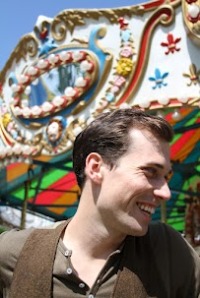Sara Holdren, the play’s director, casually dropped the phrase “clown egg registry” into one of our production meetings back in late March. For a dramaturg, this is gold, because it’s the kind of thing that essentially requires you to drop everything and find out as much as you can at that very moment. I was not surprised to find that there are virtually no scholarly resources on clown eggs; like so many things circus- and carnival-related, it’s nearly impossible to ascribe anything permanent to the clown egg phenomenon, and wild and varying tales abound. Nonetheless, some common threads do run through the story of these fascinating little monuments.
Essentially, when a clown finishes clowning school and assumes his or her clown identity, that clown registers himself or herself with one or many of the clown registries in existence. Included in that is the makeup that the clown wears, which at that moment is considered trademarked to that clown and cannot be used by anyone else. The makeup is then painted on an egg (blown-out, of course), giving physical evidence of the clown’s existence, and entered into the Clown Egg Registry.
The Clown Egg Registry is kept by the organization Clowns International in Great Britain, which touts itself as “the oldest established organization for clowns in the world” – it was founded in 1946 under the name “International Circus Clowns’ Club”. It changed its name to Clowns International in 1978, and has affiliated members worldwide. It keeps a museum near Wells in Somerset at the delightfully named “Wookey Hole” entertainment center, which contains the Egg Collection depicting the faces of members of the club.
I really, really wanted to include images of the eggs that I found on the Internet in the dramaturgy display, but they are all copyrighted to their photographer, and as such, I had not the time to obtain permission in time for opening night to use the images. But, you can view them on the photographer’s photo stream on Flickr, linked to here:
http://www.flickr.com/photos/lukestephenson/sets/72157606703952187/
More information on the eggs can be found here. Since that site is a bit hard on the eyes, I’ve reproduced verbatim the site’s page on clown eggs here; what follows in quotation marks is their work, not mine.
From http://nationalclownweek.org/eggs.shtml :
“The tradition began in the U.K. around 1946 at what was then the International Circus Clowns Club but is now called Clowns International.
A member named Stan Bult started recording clown images on chicken eggs with the insides blown out. It started as a hobby, and, like many hobbies, it just grew. Mr. Bult kept his collection at home, occasionally loaning it out for show, such as at the 1951 Centenary Exhibition of the Crystal Palace.
The collection continued to be lent out after Mr. Bult’s death but sadly most of the eggs were destroyed in an accident at one such exhibit around 1965.
Clown Bluey became chairman of Clowns International in 1984 and resurrected Mr. Bult’s practice of recording clown members’ faces on eggs. This time a professional artist was used and the faces were painted on china-pot eggs instead of chicken eggs. Over the years, many of the lost older eggs have been reproduced, and new eggs are added frequently.
The current U.K. egg artist is Kate Stone, from Bournemouth, and the collection ion display, with clown-associated pictures, portraits and artefacts at Wookey Hole Caves near Wells in Somerset. Further information may be obtained from the Curator, Mattie Faint, Tel. 0207 608 0312. (UK Phone number)
According to Clowns International, ‘The eggs are not just a record of the clown’s facial makeup, but an actual portraiture in miniature.’ In addition to paint, the artist uses samples of the clown’s costume material and wig-hair to produce an eggs-act match. A photo of the egg collection may be seen at the Clowns International website.
About twenty-five years ago, Leon ‘Buttons’ McBryde heard about the British practice of registering clown makeup using eggs. He and his wife Linda eventually met the caretaker of the British clown egg registry, and around 1979 started a similar registry for clowns in the U.S. This collection now includes over 700 eggs, covering clowns of all types from around the world. Linda McBryde is the artist and co-creator of the registry.
In the U.S. collection, the faces are hand-painted on goose eggs (more durable than chicken eggs), and decorated with various materials (such as clay, wire, felt, tiny flowers, glitter, etc.) to obtain as accurate a representation of the clown face and costume as possible.
Though not an official registry, the collection is meant to preserve the uniqueness of each clown’s face makeup. Quoting from the Department of Clown Registry information sheet: ‘It is an unwritten law among clowns that one must never copy the face of another.’ Linda McBryde told us, ‘Although this is not a legal institution, the collection is a record of the person’s name, the makeup design, and the date it was submitted. In one case that I know of, a person used the registry in a court case in which someone was infringing on his makeup design.’
The U.S. egg collection is currently in storage. Pictures of the UK collection, however, can be seen at the International Clown Hall of Fame.”
The McBrydes live not far from here, about 90 minutes southwest off I-81. Attempts to contact them to arrange a viewing of the egg collection were unsuccessful, as one might almost expect – this is carnival life, after all… !












